Leatherworking is a timeless craft that has captivated artisans for centuries, yielding an array of exquisite products renowned for their durability and beauty. Whether you're a seasoned craftsman or a novice enthusiast, having the right leather-working tools and knowledge is essential for creating quality leather goods. In this comprehensive leatherworking guide, we'll delve into the essentials of leather work gear, from the tools of the trade to the intricacies of leather types and crafting techniques. Whether you're embarking on your leatherworking journey or looking to enhance your skills, this guide has you covered.
Understanding Leatherworking Tools:
At the heart of any leatherworking endeavor lies a set of essential tools that facilitate precision and creativity. Leather-working tools encompass a diverse range, including cutting tools, stitching tools, edging tools, and finishing tools. Cutting tools such as knives, shears, and rotary cutters are used to shape and trim leather, while stitching tools like needles, thread, and awls are essential for joining leather pieces together. Edging tools, such as burnishers and edge creasers, provide a professional finish to leather edges, while finishing tools like dyes, stains, and sealants enhance the aesthetic appeal and longevity of the final product.
Types of Leather:
Understanding the characteristics of different types of leather is fundamental to successful leatherworking. Common types of leather include full grain, top grain, split grain, and bonded leather. Full grain leather, prized for its natural beauty and durability, retains the outermost layer of the hide and showcases the unique grain patterns and imperfections. Top grain leather is similar to full grain but undergoes slight processing to remove surface imperfections, resulting in a smoother appearance. Split grain leather is derived from the lower layers of the hide and is typically used for suede and lower-quality products. Bonded leather is composed of leftover leather scraps bonded together with adhesives, offering a budget-friendly alternative with reduced durability.
Leatherworking Skills and Techniques:
Mastering fundamental leatherworking skills and techniques is essential for achieving professional results. Key skills include pattern making, cutting, stitching, and finishing. Pattern making involves creating templates for leather pieces, ensuring precise measurements and proportions. Cutting requires precision and attention to detail to achieve clean edges and accurate shapes. Stitching techniques, such as saddle stitching and machine stitching, provide strong and durable seams that withstand wear and tear. Finally, finishing techniques, such as dyeing, staining, and burnishing, enhance the appearance and longevity of the final product, showcasing the craftsmanship and attention to detail of the artisan.
Exploring the Origins of Leather:
Leather, a versatile and enduring material, has been used by humans for thousands of years for various purposes. It is primarily derived from the hides and skins of animals, including cattle, sheep, goats, and pigs. The process of transforming raw hides into leather involves several stages, including tanning, dyeing, and finishing. Tanning, the most crucial step, involves treating the rawhide with tannins to stabilize and preserve it, preventing decay and imparting desirable properties such as flexibility and strength. Historically, leather has been prized for its utility in clothing, footwear, armor, and accessories, reflecting its importance in human civilization. Understanding what leather is made of and where it comes from provides insight into its rich history and enduring appeal as a valuable material.
Crafting for Beginners:
For beginners venturing into the world of leatherworking, starting with simple projects and acquiring basic skills is key to building confidence and expertise. Beginner-friendly projects include wallets, cardholders, keychains, and simple bags, which allow newcomers to practice essential techniques such as cutting, stitching, and finishing on a small scale. Investing in a starter kit containing essential leather craft tools and materials is an excellent way to kickstart your leatherworking journey, providing everything you need to get started and explore your creativity.
Conclusion:
Leatherworking is a rewarding craft that offers endless opportunities for creativity and self-expression. By equipping yourself with the right leather working tools, understanding the characteristics of different types of leather, and mastering essential skills and techniques, you can embark on a fulfilling journey of craftsmanship and creation. Whether you're a seasoned artisan or a novice enthusiast, the timeless appeal of leatherworking awaits, inviting you to explore your creativity and bring your visions to life in the form of exquisite leather goods.
Incorporating leatherworking into your repertoire of skills not only allows you to create personalized and unique items but also fosters a deeper appreciation for the artistry and craftsmanship inherent in this ancient craft. As you embark on your leatherworking journey, remember to embrace experimentation, patience, and perseverance, for they are the keys to unlocking your full potential as a leather artisan. So gather your tools, select your leather, and let your imagination soar as you embark on a journey of creativity, craftsmanship, and discovery in the captivating world of leatherworking.

